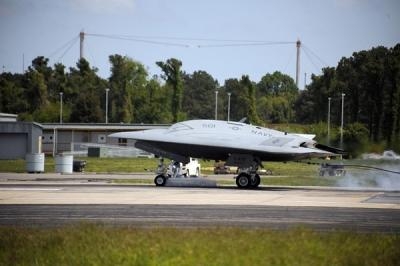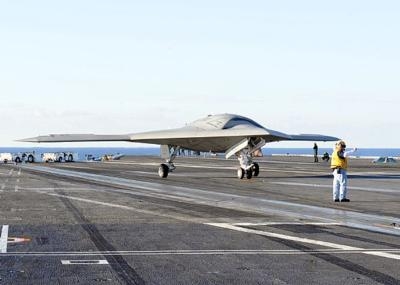Wed, May 08, 2013
Shore-Based Tests Adds Momentum, Confidence For Upcoming Carrier Trials
The first fly-in arrested landing of the X-47B Unmanned Combat Air System (UCAS) demonstrator has been successfully completed by the U.S. Navy and prime contractor Northrop Grumman. Conducted May 4 at the Navy's shore-based catapult and arresting gear complex at Patuxent River Naval Station in Maryland, the test represents the first arrested landing by a Navy unmanned aircraft. It marks the beginning of the final phase of testing prior to carrier-based trials planned for later this month.

"This precision, shore-based trap by the X-47B puts the UCAS Carrier Demonstration (UCAS-D) program on final approach for a rendezvous with naval aviation history," said Capt. Jaime Engdahl, the Navy's UCAS program manager. "It moves us a critical step closer to proving that unmanned systems can be integrated seamlessly into Navy carrier operations."
During an arrested landing, the incoming aircraft extends its landing hook to catch a heavy cable extended across the aircraft landing area. The tension in the wire brings the aircraft to a rapid and controlled stop. Carl Johnson, vice president and Navy UCAS program manager for Northrop Grumman, said this first arrested landing reinforced what the team already knew. "The X-47B air vehicle performs exactly as predicted by the modeling, simulation and surrogate testing we did early in the UCAS-D program," Johnson said. "It takes off, flies and lands within a few feet of its predicted path."
The arrested landing test culminates more than three months of shore-based carrier suitability testing at Naval Air Station Patuxent River. The testing included precision approaches, touch-and-go landings, and precision landings by the X-47B air vehicle. For the arrested landing, the X-47B used a navigation approach that closely mimics the technique it will use to land on an aircraft carrier underway at sea.

Later this month, the aircraft will undergo sea-based carrier testing, catapulting from the carrier deck and potentially completing landings aboard USS George H.W. Bush (CVN 77). "The entire system has performed very well across a large set of shore-based testing events including aircraft performance, flying qualities, navigation performance, catapult launches, and precision landings designed to stress system operation," Engdahl said. "Our final carrier-landing software simulation shows excellent performance, flight test results are very good, and we are confident the X-47B will perform well on the ship."
The X-47B is a tailless, autonomous aircraft designed with unique features for an unmanned aircraft, such as carrier suitable landing gear and structure. While the X-47B itself will not be used for operational use, the UCAS-D program is developing a concept of operations and demonstrating technologies for use in follow-on unmanned carrier based aircraft programs.
(Images provided by the U.S. Navy)
More News
Execute Missed Approach Instructions issued to a pilot making an instrument approach which means continue inbound to the missed approach point and execute the missed approach proce>[...]
Aero Linx: British Helicopter Association (BHA) The BHA promotes the compliant, safe and considerate use of rotorcraft throughout the UK. Its activities are directed by a Council o>[...]
During An Aerial Application Flight, The Engine Lost Power And The Airplane Began To Descend Analysis: The pilot reported that, during an aerial application flight, the engine lost>[...]
Also: AMA Names Tyler Dobbs, More Falcon 9 Ops, Firefly Launch Unsuccessful, Autonomous F-16s The Air Force has begun ground testing a future uncrewed jet design in a milestone tow>[...]
Aero Linx: HeliOffshore HeliOffshore is the global, safety-focused association for the offshore helicopter industry. Our mission is to lead a collective safety conversation, identi>[...]
 ANN's Daily Aero-Term (05.12.25): Execute Missed Approach
ANN's Daily Aero-Term (05.12.25): Execute Missed Approach ANN's Daily Aero-Linx (05.12.25)
ANN's Daily Aero-Linx (05.12.25) NTSB Final Report: Piper PA-36-375
NTSB Final Report: Piper PA-36-375 Airborne-NextGen 05.06.25: AF Uncrewed Fighters, Drones v Planes, Joby Crew Test
Airborne-NextGen 05.06.25: AF Uncrewed Fighters, Drones v Planes, Joby Crew Test ANN's Daily Aero-Linx (05.13.25)
ANN's Daily Aero-Linx (05.13.25)




